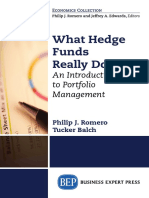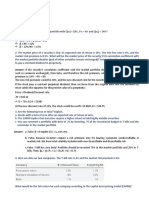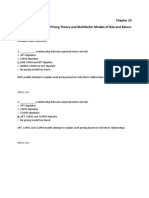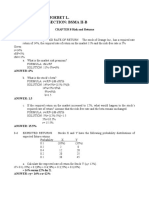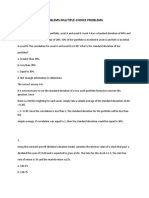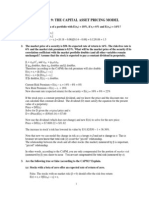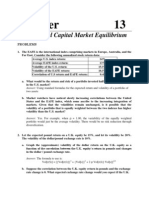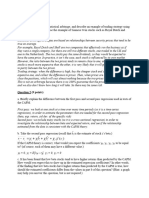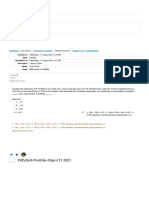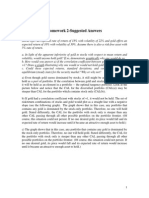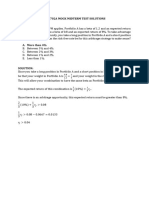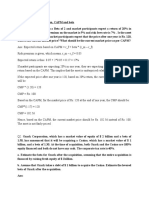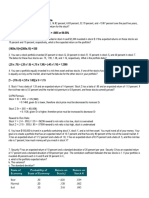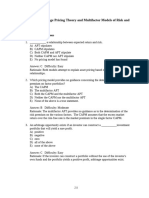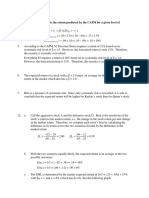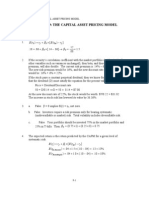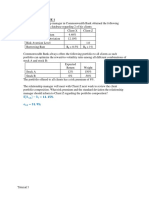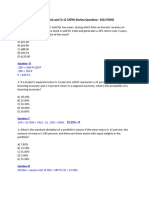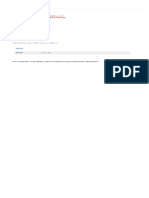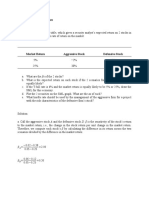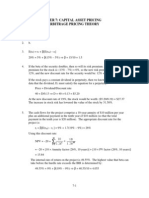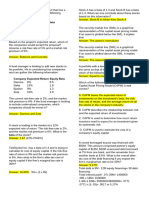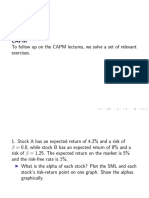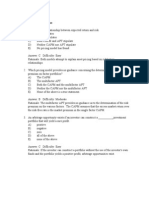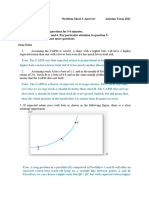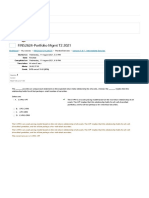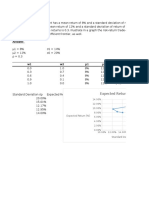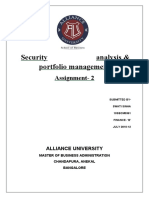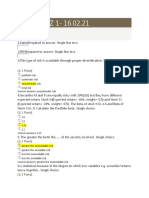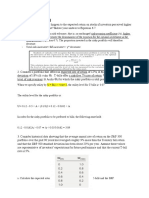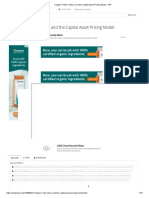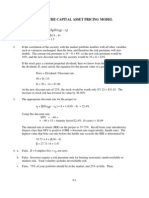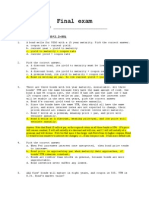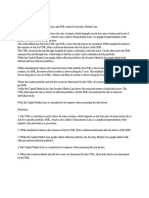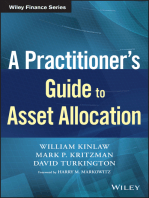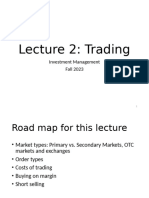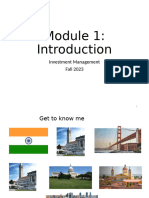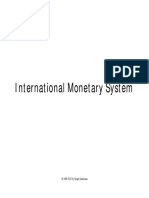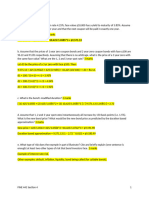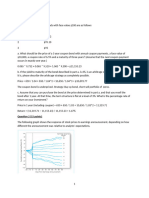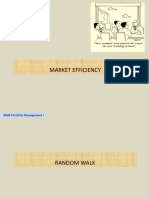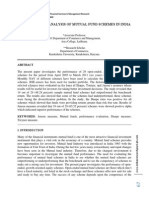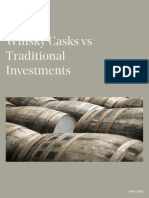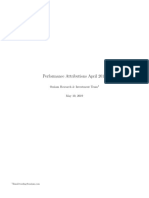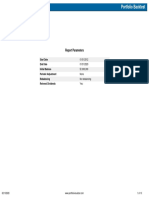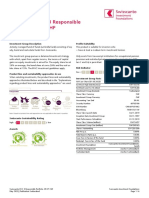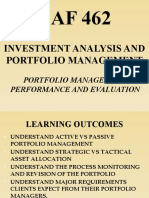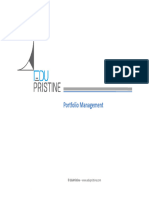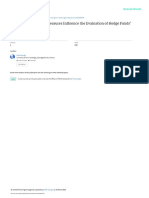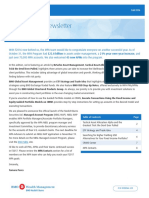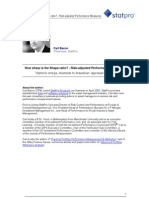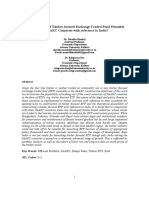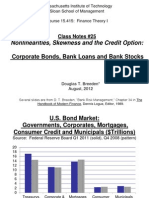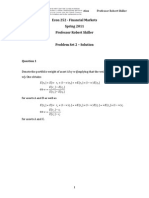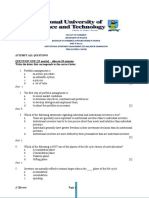441 Final Sample Questions
441 Final Sample Questions
Uploaded by
yifeihufionaCopyright:
Available Formats
441 Final Sample Questions
441 Final Sample Questions
Uploaded by
yifeihufionaOriginal Title
Copyright
Available Formats
Share this document
Did you find this document useful?
Is this content inappropriate?
Copyright:
Available Formats
441 Final Sample Questions
441 Final Sample Questions
Uploaded by
yifeihufionaCopyright:
Available Formats
Question 1
a. If the CAPM is valid, is the following situation possible? Explain your answer.
Stock Exp return Std dev
A 10% 25%
B 12% 20%
Yes. According to the CAPM there is no connection between expected return and standard
deviation for individual stocks, so anything would be possible in such a table.
b. If the CAPM is valid, is the following situation possible? Explain your answer.
Stock Exp return Beta
A 10% 1
B 14% 1.5
C 4% 0
Stock A => E[rM]=10%
Stock C => rf = 4%
CAPM => Stock B’s expected return = 4% + 1.5 (10% - 4%) = 13%.
Impossible.
c. If the CAPM is valid and the risk free rate is 2%, is the following situation possible?
Explain your answer.
Exp ret Std dev
Market 8% 16%
Stock A 12% 18%
Sharpe ratio of market = (8 – 2) / 16 = 0.375
Sharpe ratio of stock A = (12 – 2) / 18 = 0.56
Impossible because, according to the CAPM, the market portfolio has the highest possible
Sharpe ratio
d. If the CAPM is valid, the risk free rate is 2% and the correlation between Tristan and Isolde
is minus 0.2, is the following situation possible? Explain your answer.
Exp return Std dev
Market portfolio 8% 15%
Tristan hedge fund 11% 26%
Isolde hedge fund 13% 32%
(Hint: compute the expected return and standard deviation of an equally weighted portfolio of
Tristan and Isolde).
Exp. Return of equally weighted portfolio = 12%
Variance = (0.5)^2 (0.26)^2 + (0.5)^2(0.32)^2 -2 (0.5) (0.5) (.2) (.26) (.32) = 0.03418
Std dev. = 18.49%
Sharpe ratio of portfolio = (12 – 2) / 18.49 = 0.54
Sharpe ratio of market = (8 – 2) / 15 = 0.4
Impossible because, if the CAPM holds, the market has the highest Sharpe ratio.
Question 2
The expected rates of return of funds A and B are 8% and 6%, respectively. The beta of fund
A is 0.9, while that of fund B is 1.2. The standard deviation of A is 28% annually, while that
of B is 19%.
The riskless rate is currently 1%. The expected rate of return on the market portfolio is 6%
and its standard deviation is 15%.
a. If you currently hold the market portfolio, would you choose to add either of these funds to
your holdings?
In this situation the alpha is the relevant performance measure:
Alpha of A = 2.5%
Alpha of B = -1%
A is interesting. The manager could charge up to 1% extra fee and still have a positive alpha.
b. If instead you could invest only in riskless assets plus only one of these funds, which one
would you choose?
Sharpe ratio of A = 0.25
SR of B = 0.263
B is more interesting
c. Which one of the two funds is better diversified? (Hint: assume that the risk free rate is
constant over time, so var(R i-Rf) = var(Ri) and var(i(Rm-Rf)) = var(iRm) = i2var(Rm))
Look at R2= var(i(Rm-Rf)) / var(Ri-Rf)
Fund A: 0.92(0.15)2/0.282 = 0.23
Fund B: 1.22(0.15)2/0.192 = 0.90
Fund B is better diversified
Question 3
Assume that the stock of Vandalay Industries trades for $117, and
that the interest rate over the next year is 2.5% (the same rate
applies for lending and borrowing).
a. What should be the price of a forward contract to purchase one
share of Vandalay in one year?
Replicating strategy: borrow $117 to purchase one share right now.
Then you have to repay $119.93 in one year.
So the forward price must be $119.93
b. Assume that the forward price is equal to your answer in part a,
minus one dollar. Can you propose an arbitrage strategy? Please
describe it as precisely as possible.
Today:
Sign one forward contract to buy in one year (forward price =
118.93).
Short sell one share of Vandalay right now.
Invest the proceeds of the sale ($117) in riskless assets.
In one year:
You receive $119.93 from the riskless investment.
You pay $118.93 and receive one share from the forward contract.
You use that share to end the short sale.
Net profit: one dollar per share.
Question 4
In the context of the single factor version of the APT, take two stocks
that are exposed to the same factor of risk. There is no specific risk,
and the risk free rate is 3%.
o Krueger: expected return = 10%, factor loading = 2
o Pendant: expected return = 8%, factor loading = 1
a. Is arbitrage available? If it is, describe the arbitrage strategy as
precisely as possible.
APT implies: E[rP] = rf + RP => RP = 5%
But then Krueger’s expected return must be r f + 2 RP = 13%, so
Krueger is a bad deal (low expected return/overpriced).
Form a portfolio with 50% Krueger, 50% riskless assets. It has an
expected return of 6.5% and a factor sensitivity of one.
Short sell the portfolio and invest in Pendant. Risk cancels out and
the profit is 1.5% of the portfolio value (for example, if you short sell
$10,000 of the portfolio and buy $10,000 worth of Pendant, the profit
is $150).
b. Briefly explain how, in the real world where specific risk is present,
a hedge fund would take advantage of this type of situation.
The hedge fund would find short sell many stocks that are overpriced
and buy many stocks that are underpriced. It would adjust the
amounts so that the factor sensitivity is approximately zero. The
specific risks would be diversified away and have a negligible impact
on the P/L.
Question 5
“The standard deviation of a portfolio is always equal to the weighted
average of the standard deviations of the individual components of
the portfolio.” True or false? Please briefly explain your answer.
False. The formula shows that the standard deviation of the portfolio
is always less than the weighted average, except when the
correlation is one (in that case, it is equal).
You might also like
- What Hedge Really Funds Do PDFDocument148 pagesWhat Hedge Really Funds Do PDFyaman aroraNo ratings yet
- Selected Q&A - Chapter 09Document11 pagesSelected Q&A - Chapter 09Gakiya Sultana50% (2)
- Essentials of Investments 10th Edition Bodie Solutions Manual DownloadDocument14 pagesEssentials of Investments 10th Edition Bodie Solutions Manual DownloadJennifer Walker100% (21)
- Test Bank Chapter 10 Investment BodieDocument45 pagesTest Bank Chapter 10 Investment BodieTami DoanNo ratings yet
- Axioma - ModelUpdate WW4 Jan2018 2Document34 pagesAxioma - ModelUpdate WW4 Jan2018 2orienteNo ratings yet
- Advanced Portfolio Management: A Quant's Guide for Fundamental InvestorsFrom EverandAdvanced Portfolio Management: A Quant's Guide for Fundamental InvestorsNo ratings yet
- Tasc 2022 - 03Document64 pagesTasc 2022 - 03Daniel Boureanu100% (3)
- Name: Debuyan, Joebet L. Course, Year & Section: Bsma Ii-B: CHAPTER 8 Risk and ReturnsDocument20 pagesName: Debuyan, Joebet L. Course, Year & Section: Bsma Ii-B: CHAPTER 8 Risk and ReturnsJoebet Debuyan100% (1)
- Chapter 9 Multiple Choice QuestionsDocument32 pagesChapter 9 Multiple Choice Questionsmistermakaveli0% (1)
- BKM CH 09 Answers W CFAhgigoitDocument10 pagesBKM CH 09 Answers W CFAhgigoitbananpolis100% (11)
- Chap 7 End of Chap SolDocument13 pagesChap 7 End of Chap SolWan Chee100% (1)
- Sample Final Exam Larkin AnswersDocument18 pagesSample Final Exam Larkin AnswersLovejot SinghNo ratings yet
- ExerExercise Sample 1Document5 pagesExerExercise Sample 1sonicyulioNo ratings yet
- Exercises On Chapter Five - Return & CAPM Oct. 19 - AnswerDocument10 pagesExercises On Chapter Five - Return & CAPM Oct. 19 - Answerbassant_hegaziNo ratings yet
- Ch13 HintsDocument3 pagesCh13 HintsEric ChenNo ratings yet
- T1 FRM 5 Ch5 26 32 60 61 403 404 20.8 20.9 v3 4 - 6120adda7e8e9Document48 pagesT1 FRM 5 Ch5 26 32 60 61 403 404 20.8 20.9 v3 4 - 6120adda7e8e9Christian Rey Magtibay0% (1)
- 441 Midterm2Document7 pages441 Midterm2yifeihufionaNo ratings yet
- Seminar QuestionsDocument35 pagesSeminar QuestionsDaniel SanchezNo ratings yet
- Lectures 5 & 7 - Hard Exercises - Attempt ReviewDocument11 pagesLectures 5 & 7 - Hard Exercises - Attempt ReviewHeidi DaoNo ratings yet
- hw2 2015 Bpes SolutionsDocument7 pageshw2 2015 Bpes SolutionsDaryl Khoo Tiong Jinn100% (1)
- Fin 6310-Investment Theory and Practice Homework 6: Chapter - 9Document5 pagesFin 6310-Investment Theory and Practice Homework 6: Chapter - 9Ashna AggarwalNo ratings yet
- Chapter 9: The Capital Asset Pricing Model: Problem SetsDocument11 pagesChapter 9: The Capital Asset Pricing Model: Problem SetsBiloni KadakiaNo ratings yet
- Mock Test SolutionsDocument13 pagesMock Test SolutionsMyraNo ratings yet
- 2021 Tutorial 3Document7 pages2021 Tutorial 3Ashish KumarNo ratings yet
- Chapter 11Document7 pagesChapter 11NguyenThiTuOanhNo ratings yet
- HW 03 SolutionDocument4 pagesHW 03 Solutionchauanh29424No ratings yet
- Chapter 9: The Capital Asset Pricing Model: Problem SetsDocument10 pagesChapter 9: The Capital Asset Pricing Model: Problem SetsnouraNo ratings yet
- IACFMAS-ASSIGN MarjDocument4 pagesIACFMAS-ASSIGN MarjMarjorie PagsinuhinNo ratings yet
- Arbitrage Pricing Theory and Multifactor Models QuestionsDocument27 pagesArbitrage Pricing Theory and Multifactor Models QuestionsNermine LimemeNo ratings yet
- 2012 PPP III & SolutionDocument10 pages2012 PPP III & SolutiontimNo ratings yet
- Solutions Chapter 09 CAPM and APTDocument6 pagesSolutions Chapter 09 CAPM and APTA ChowdhuryNo ratings yet
- InvestmentsDocument11 pagesInvestmentsalvinn_8No ratings yet
- Chapter7 Endofchapterquestions Capitalassetpricing - 24117Document13 pagesChapter7 Endofchapterquestions Capitalassetpricing - 24117Mudit GoelNo ratings yet
- BKM_10e_Chap007Document20 pagesBKM_10e_Chap007Kim BumwooNo ratings yet
- Homework3 With AnsDocument14 pagesHomework3 With AnsLiangWei KhoNo ratings yet
- Finance BIS & FMI SheetDocument13 pagesFinance BIS & FMI SheetSouliman MuhammadNo ratings yet
- Tutorial 5 - SolutionsDocument8 pagesTutorial 5 - SolutionsstoryNo ratings yet
- Unit 9 - Review Questions - Solutions (2024)Document6 pagesUnit 9 - Review Questions - Solutions (2024)phillipmchau2004No ratings yet
- Investments 13E - Bodie Connect 答案 Chapter 09Document46 pagesInvestments 13E - Bodie Connect 答案 Chapter 09zhiyuantan050No ratings yet
- PS 2Document6 pagesPS 2WristWork EntertainmentNo ratings yet
- Additional CAPM ExercisesDocument8 pagesAdditional CAPM ExercisesMuhammad OsamaNo ratings yet
- Problem Set 2Document4 pagesProblem Set 2Omar SrourNo ratings yet
- Capital Asset Pricing Theory and Arbitrage Pricing TheoryDocument19 pagesCapital Asset Pricing Theory and Arbitrage Pricing TheoryMohammed ShafiNo ratings yet
- 1.3.2.1 Elaborate Problem Solving AssignmentDocument17 pages1.3.2.1 Elaborate Problem Solving AssignmentYess poooNo ratings yet
- Chapter 7Document14 pagesChapter 7jobert27No ratings yet
- CAPM and interest pratice testDocument4 pagesCAPM and interest pratice testKris CollinNo ratings yet
- CAPM Recap Exercises 2023 SolutionDocument15 pagesCAPM Recap Exercises 2023 SolutionMirela KafalievaNo ratings yet
- Sample ProbsDocument27 pagesSample Probsals7No ratings yet
- Solution ProblemSet3 TPDocument7 pagesSolution ProblemSet3 TPMustafa ChatilaNo ratings yet
- Lectures 5 & 7 - Intermediate Exercises - Attempt ReviewDocument18 pagesLectures 5 & 7 - Intermediate Exercises - Attempt ReviewHeidi DaoNo ratings yet
- Prob 14Document6 pagesProb 14LaxminarayanaMurthyNo ratings yet
- Module 1 Group Study QuestionsDocument14 pagesModule 1 Group Study QuestionsivanaNo ratings yet
- Problem Set 1Document3 pagesProblem Set 1ikramraya0No ratings yet
- Tutorial Solutions5Document8 pagesTutorial Solutions5Yilin YANGNo ratings yet
- Sapm (10SBCM0361) Assignment - 2Document7 pagesSapm (10SBCM0361) Assignment - 2Swati SinhaNo ratings yet
- SAPM QUIZ 1-16.02.21: PointsDocument13 pagesSAPM QUIZ 1-16.02.21: Pointsakshay rautNo ratings yet
- Tutorial 3-IpmDocument6 pagesTutorial 3-IpmNguyễn Phương ThảoNo ratings yet
- Chapter 7 Risk, Return, and The Capital Asset Pricing Model: AWS Cloud Security RisksDocument18 pagesChapter 7 Risk, Return, and The Capital Asset Pricing Model: AWS Cloud Security RisksPauline Tracy BatilesNo ratings yet
- Chapter 9: The Capital Asset Pricing ModelDocument8 pagesChapter 9: The Capital Asset Pricing ModelSilviu TrebuianNo ratings yet
- Risk and Returns TutorialDocument7 pagesRisk and Returns Tutorialtfqg6yn6gjNo ratings yet
- Final AnswerDocument15 pagesFinal AnswerHedNo ratings yet
- CML Vs SMLDocument9 pagesCML Vs SMLJoanna JacksonNo ratings yet
- ps3 2010Document6 pagesps3 2010Ives LeeNo ratings yet
- Fine 441 Module2 TradingDocument51 pagesFine 441 Module2 TradingyifeihufionaNo ratings yet
- Fine 441 Module1 IntroductionDocument59 pagesFine 441 Module1 IntroductionyifeihufionaNo ratings yet
- 08 IMS-CrisesDocument40 pages08 IMS-CrisesyifeihufionaNo ratings yet
- 441 Final22 SolDocument9 pages441 Final22 SolyifeihufionaNo ratings yet
- 441 Final Quiz 2021Document6 pages441 Final Quiz 2021yifeihufionaNo ratings yet
- Market EfficiencyDocument233 pagesMarket EfficiencyRa'fat JalladNo ratings yet
- A Comparative Analysis of Mutual Fund Schemes in IndiaDocument13 pagesA Comparative Analysis of Mutual Fund Schemes in IndiagomsinghNo ratings yet
- Whisky Casks Vs Traditional AssetsDocument11 pagesWhisky Casks Vs Traditional AssetsbersekvelikyNo ratings yet
- Performance Attribution - Ossiam ResearchDocument8 pagesPerformance Attribution - Ossiam ResearchLuis VelardeNo ratings yet
- Atul Kharat (Major Project)Document50 pagesAtul Kharat (Major Project)Nikhil JadhavNo ratings yet
- Fyp Portfolio Management Mutual Fund Analysis SBIDocument50 pagesFyp Portfolio Management Mutual Fund Analysis SBIShivaji Rao Karthik VagmoreNo ratings yet
- UVXY Jan 2012 - Jan 2020Document10 pagesUVXY Jan 2012 - Jan 2020kuky6549369No ratings yet
- CA Final AFM Q MTP 1 Nov 2024 Exam Castudynotes ComDocument9 pagesCA Final AFM Q MTP 1 Nov 2024 Exam Castudynotes Comkeshavjindal759No ratings yet
- Evaluation of Portfolio PerformanceDocument10 pagesEvaluation of Portfolio PerformanceGourav Baid100% (1)
- FSD CH0497631082 SWC CH enDocument6 pagesFSD CH0497631082 SWC CH enshuzefaNo ratings yet
- Mutual Funds: Answer Role of Mutual Funds in The Financial Market: Mutual Funds Have Opened New Vistas ToDocument43 pagesMutual Funds: Answer Role of Mutual Funds in The Financial Market: Mutual Funds Have Opened New Vistas ToNidhi Kaushik100% (1)
- BAF 462 Investment AnalysisDocument37 pagesBAF 462 Investment AnalysisLaston MilanziNo ratings yet
- Portfolio Management MMDocument31 pagesPortfolio Management MMTu DuongNo ratings yet
- Speculator Spreading Pressure and The CommodityDocument45 pagesSpeculator Spreading Pressure and The CommodityPatrickNo ratings yet
- HelaMzoughi PublishedPaperDocument15 pagesHelaMzoughi PublishedPapersonia969696No ratings yet
- Project ReportDocument42 pagesProject ReportAnkit Kumar PandeyNo ratings yet
- 19 Performance EvaluationDocument28 pages19 Performance EvaluationSAHIL GUPTA100% (1)
- Tactical Asset Allocation Alpha and The Greatest Trick The Devil Ever PulledDocument8 pagesTactical Asset Allocation Alpha and The Greatest Trick The Devil Ever PulledGestaltUNo ratings yet
- How Sharp Is The Shape-Ratio? - Risk-Adjusted Performance MeasuresDocument13 pagesHow Sharp Is The Shape-Ratio? - Risk-Adjusted Performance MeasuresMaggie HartonoNo ratings yet
- IMIB-EGADE-2018 Paper 93Document41 pagesIMIB-EGADE-2018 Paper 93Rituparna DasNo ratings yet
- Corporate Risk and Credit RiskDocument78 pagesCorporate Risk and Credit Riskcfang_2005No ratings yet
- The Information RatioDocument8 pagesThe Information RatiomeetpcNo ratings yet
- Econ 252 Spring 2011 Problem Set 2 SolutionDocument13 pagesEcon 252 Spring 2011 Problem Set 2 SolutionTu ShirotaNo ratings yet
- 2017 CFA Level 2 Mock Exam MorningDocument40 pages2017 CFA Level 2 Mock Exam MorningElsiiieNo ratings yet
- QUESTION ONE (25 Marks) - Allocate 10 Minutes Write The Letter That Corresponds To The Correct LetterDocument11 pagesQUESTION ONE (25 Marks) - Allocate 10 Minutes Write The Letter That Corresponds To The Correct LetterTina LuwoNo ratings yet
